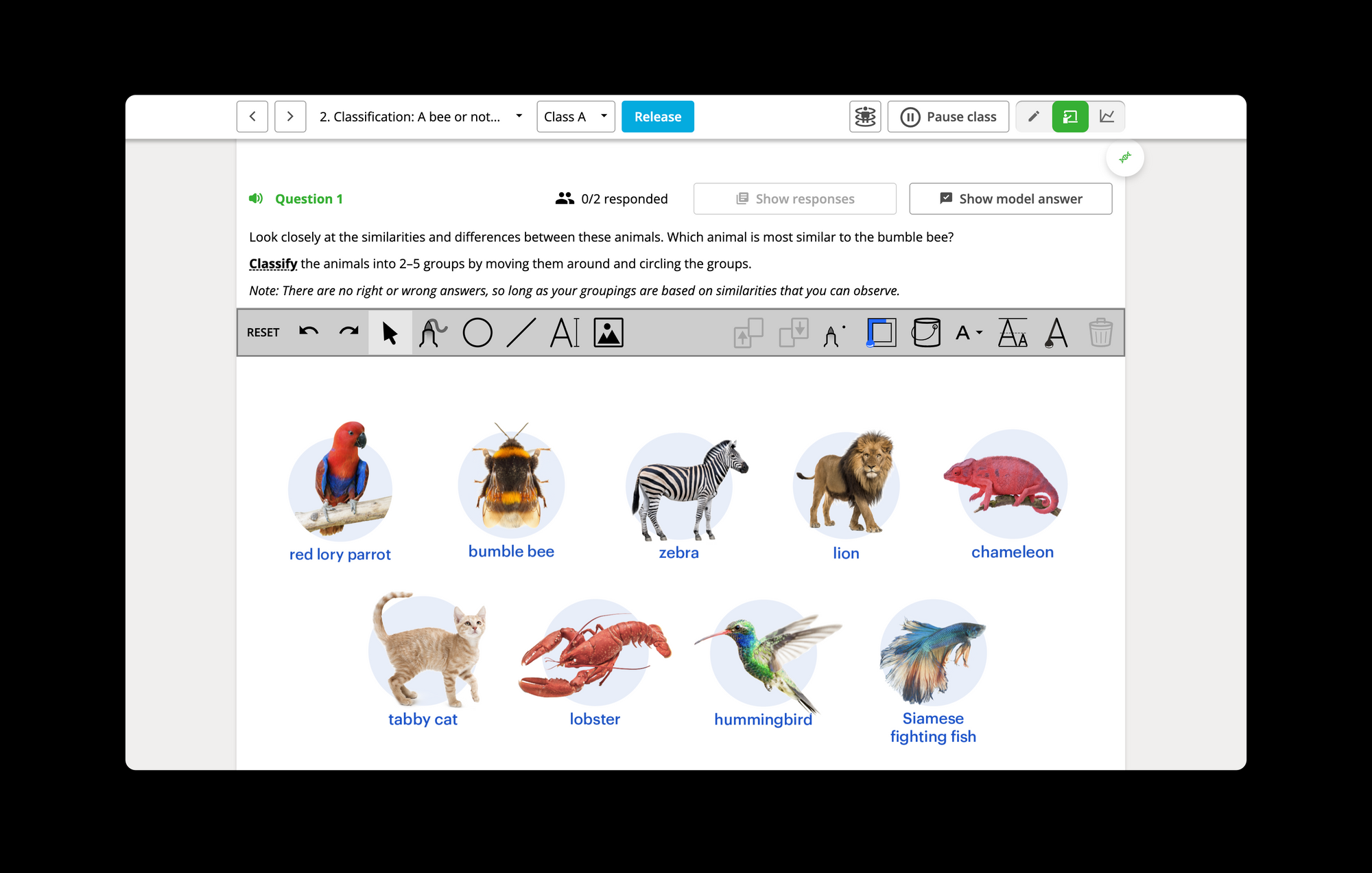Introducing: Pop-up definitions to support literacy

We want to make science more accessible to every student. To make this a reality, we've created a handy new feature: Pop-up definitions! While we start rolling this out, read on to find out more about how pop-up definitions work.
For a first look at pop-up definitions, check out our latest breaking news lesson: Scientists use lasers to steer lightning bolts!.
What are pop-up definitions?
We've had glossary lessons containing lists of unit-specific vocabulary in each of our units for ages. But, more recently, teachers have asked if we could make these more interactive. This set the wheels in motion for pop-up definitions.
Within a Stile lesson, pop-up definitions allow students to see in-line definitions of scientific terminology and cognitive verbs. These words appear with a blue line beneath them. By holding their cursor over the underlined word, your students will see a definition and associated image. They can also click the speaker icon to hear this information read aloud.

To support Spanish-speaking students at Stile schools in the USA, there's an additional button to switch the word, definition, and audio into Spanish. This will support these students in making connections between English and Spanish words and to interpret the text while strengthening their English vocabulary.
Why use pop-up definitions?
Pop-up definitions have been shown to support reading comprehension and vocabulary acquisition (Lenders, 2008). This is especially true when the defined words aren't seen or heard frequently in students' daily lives. We've worked with experts in English Language Development to design and implement a tool that helps your students interpret scientific terminology and improve their understanding.
Which words have definitions available?
The effectiveness of pop-up definitions and their impact on students "depend critically on the specific rules for glossing words" (Cohen, Tracy & Cohen, 2017, p.262). There's an additional cognitive load associated with using this type of tool as students switch from reading the text to the definition and then apply the definition in context (ibid.). For this reason, we've been careful not to include too many words and to provide definitions only where they support comprehension. This is also why we've chosen not to include pop-up definitions in our collection of primary school units.
We've mainly defined three categories of words, though you might also notice us using pop-up definitions to provide supporting information too. For example, the name of a city or landmark may show details and a map of its location.
The three main categories are:
- Terminology from the unit's glossary
The existing glossary list for each unit provides an excellent source of relevant words and phrases. These terms are written in bold text when they are first defined and don't have a pop-up definition available because their definition is already stated in the text. Each glossary term is defined in the lesson's text at some point within the unit. These same terms are found in the glossary for Stile X and students can revise them using the flashcards in the Stile X app. - General scientific terminology
Where relevant, we've also included definitions for broader scientific terms. For example, if the word "hypothesis" appears in a lesson, a definition is available. Building students' familiarity with these terms is crucial for their scientific literacy. - Cognitive verbs
Each question in Stile incorporates a cognitive verb. These verbs appear in bold text and give students clear information about how to answer the question. The use of cognitive verbs through frameworks such as SOLO taxonomy supports development of metacognition and self-regulation (Hook, 2018.) but students must first understand their meaning. Student-friendly definitions are available when hovering the cursor over a question's cognitive verb. To avoid confusion with other definitions, cognitive verbs do not include an image and explicitly refer to how students can use the verb to answer the question. To reduce cognitive load, we haven't defined Depth of Knowledge Level 1 terms like "identify", "name" and "recall".

Talking to students about pop-up definitions
We recommend taking a minute or two to introduce this new feature to your students when you first encounter it. If they're anything like my students, they might've already discovered it themselves!
Using Teach Mode, project your screen at the front of the room and point out the underlined words in the text. Demonstrate how holding your cursor over these words brings up a definition, image, and speaker icon that will read the text aloud. An effective strategy for using pop-up definitions is to try to interpret the word's meaning in context before checking the definition. You might like to model this approach for students at the front of the room by thinking aloud. For example, "I see there is a glossary word here. I'm going to read this sentence to see if I understand it before I check the definition. I think I know what an asteroid is, it's something to do with objects in space… I'm going to keep reading to see if my understanding makes sense… Now that I've read a bit further, I think I need to check exactly what it means, because I'm not sure I really understand this section of text without it. I'll hold my mouse over the word and now I can see that an asteroid is a large space rock that orbits the Sun, so when I look back at what I was reading, I understand that there are large space rocks that orbit the Sun between Mars and Jupiter."
Your students may already be familiar with cognitive verbs and how to use them to respond to a question appropriately. If not, check out the Stile Skill builder lesson, designed to help you introduce these words and what they mean. When demonstrating the pop-up definitions with these terms, scroll to a question and show the underlined cognitive verb, with its definition. Explain that these words are intended to help them understand the level of thinking required for the question, and to construct an appropriate answer. Show a variety of questions with different verbs to demonstrate the guidance each one provides.
We'd love to hear your thoughts and experiences with pop-up definitions. Reach out to me at alexandra.russell@stileeducation.com to provide feedback or ask questions.
Special thanks
Special thanks goes to Danielle Pukansky and Jessica Spanel who provided their advice and expertise during the development of the pop-up definitions tool.

Danielle Pukansky
Danielle Pukansky is an English Language Development teacher at North Middle School, Aurora, Colorado.

Jessica Spanel
Jessica Spanel is a Culturally and Linguistically Diverse Education Professional Learning Coordinator for Aurora Public Schools, Aurora, Colorado. Through Professional Learning, she supports teachers to plan for multilingual learners so that students at all levels of language proficiency can engage in meaningful grade level content while developing English. Jessica has taught multiple grade levels K-12, but has a love for middle school.
References
Cohen, D.; Tracy, R. & Cohen, J. (2017) On the Effectiveness of Pop-Up English Language Glossary Accommodations for EL Students in Large-Scale Assessments, Applied Measurement in Education, 30:4, 259-272, DOI: 10.1080/08957347.2017.1353986
Hook, P. (2013.) About SOLO Taxonomy [brochure]. Essential Resources.
Lenders, O. (2008). Electronic glossing – is it worth the effort? Computer Assisted Language Learning, 21(5), 457–481. doi:10.1080/09588220802447933

